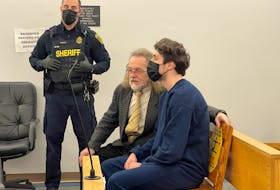WARNING: Graphic content in this story may disturb some readers.
In her apartment in the early morning hours of May 9, 2016, Anne Norris was allegedly consumed by anxiety. Marcel Reardon was outside, and she was convinced he was planning to break in and sexually assault her as she slept. Driven into a psychotic state, Norris picked up the hammer she had purchased hours earlier and went downstairs, then outside where Reardon was lying, passed out drunk in the grass, face-down.
She attacked him with the hammer, striking him so many times in the head that she couldn’t count them. She had been convinced for years that people were sexually assaulting her as she slept — allegations that were not substantiated — and feared Reardon would do the same or worse if she didn’t stop him first.
“I had no choice,” Norris told a forensic psychiatrist about a year and a half later. “I just couldn’t stop. I couldn’t think of the repercussions. I had given up the fight, I was going to kill myself. No one cared if I lived. I had no support.”
Reardon opened his eyes at one point and looked at her, she told Dr. Nizar Ladha. He stopped breathing. She moved his body under a set of concrete steps and kept hitting, she said, because he wasn’t yet dead.
Related stories:
Anne Norris thought what she was doing was right, psychiatrist tells St. John’s murder trial
The murder trial of Anne Norris: what you need to know
“I was so out of control,” Norris told Ladha. “I went to the police, I went to the hospital, but no one cared. Police didn’t do anything. No one helped.”
Norris then went back inside and changed her clothes, hanging her blood-specked scarf neatly in her closet with her other scarves, and placing her sneakers on a high shelf. She washed her face, changed her bloodstained jeans and put them in a backpack with the hammer, then walked to the waterfront and tossed the backpack into the harbour.
This is Norris’s own version of the night she killed Reardon, 46, behind her Brazil Street apartment building. They moved in similar social circles, both living in various shelters and spending time on the streets, hanging out with others, drinking and chatting. That’s what they had done for most of the day on May 8, before Norris left and went to Walmart “to pick up a few things for my apartment,” she told Ladha.
Those items consisted of three hammers, two bath towels, four knives and other items, though she ended up only buying one hammer and a knife when her debit card was declined.
Norris returned downtown and later that night, she and Reardon ended up in a cab together and went back to her apartment, where she killed him. She was arrested four days later at the same Walmart, attempting to purchase another hammer.
Ladha took the stand at Norris’s first-degree murder trial for the second day Tuesday, as one of the last witnesses for defence lawyers Rosellen Sullivan and Jerome Kennedy.
He told the court he had been hired by the lawyers to conduct a psychiatric assessment on Norris after she was charged with Reardon’s murder, and had met with her four times: June 1, 2016, twice in September 2016, and once more last December, as he was preparing for the trial. He didn’t bring up Reardon’s death until the second meeting, and noted Norris’s lack of appropriate anxiety when she spoke about it, as well as her flat tone. Speaking about Reardon in December, Norris cried, Ladha said.
Psychopaths often have a lack of empathy and anxiety, he explained, though he suspected Norris wasn’t a psychopath. Psychological testing later confirmed this, he said.
Instead, Ladha said he diagnosed Norris with schizophrenia, and concluded she was in a psychotic state when she killed Reardon, driven by years of delusions of sexual assaults.
It’s a conclusion Crown prosecutors Iain Hollett and Jeff Summers challenged in court Tuesday afternoon.
Responding to Hollett’s questioning, Ladha said Norris likely did know what she was doing was legally and morally wrong, but in a psychotic state of mind and believing she was in danger, she felt she had no choice but to kill Reardon.
Norris had said she was not taking her medication, Ladha told the court, though he did not notice any symptoms of psychosis the first time he had met with her, three weeks after Reardon’s death.
“Did you consider the possibility that she was asymptomatic on May 9 as well?” Hollett asked.
“It’s a different day,” Ladha responded, explaining symptoms of psychosis can come and go. “It’s my belief she was certainly ill on that day.”
Hollett asked Ladha why he hadn’t consulted the police file or the statements from those who had been in contact with Norris during the days before and after Reardon’s death to corroborate his belief. Ladha explained the information he had from Norris and her parents, as well as Norris’s medical history, was enough to put her symptoms in context and lead him to a schizophrenia diagnosis.
“So your conclusion that Anne Norris was suffering symptoms of psychosis on May 8 and 9 was based exclusively on what she told you?”
“Correct,” Ladha replied.
Hollett pointed out Norris’s father had testified to speaking with her May 7 and described her as in a “good frame of mind,” and Norris had given statements to police saying she felt her “mental health was good” and she was “back on medication and it helped tremendously.”
Reading Ladha’s notes, Hollett pointed out Norris had said she felt ready to be discharged from hospital days before Reardon’s death.
“Isn’t that consistent with her feeling good May 8 and 9?” Hollett asked.
“Not really,” Ladha said, pointing out Norris had purchased a hammer for protection because she was fearful of perceived attacks while she slept. “That indicates to me that she’s not in a good mental state, she’s fearful.”
“I don’t know about that. She told you she wanted to pick up some things for her apartment. She’s not telling you she’s afraid,” Hollett countered.
“Why did she want a hammer and a knife?” Ladha replied.
“Do you have a hammer at home?” Hollett responded.
Hollett also pointed out portions of Norris’s police statements where she lied about meeting Reardon until she was confronted with evidence, where she told police she had walked home alone and where she said she had read a book in her apartment and had done nothing else. When asked if she had any idea what happened to the person found under the steps, Norris had told police, “I have no idea, no,” and, “I don’t know anything about it.”
“Given that she is asked questions and she told lies, doesn’t it give you cause for concern?” Hollett asked Ladha, who replied, “Of course it causes me concern. But you’ve got to put it in context.”
Norris’s lawyers say she should be found not criminally responsible for Reardon’s death due to a severe mental illness, while Hollett and fellow prosecutor Jeff Summers say she planned and deliberately killed Reardon, knowing what she was doing.
Hollett will continue his cross-examination Wednesday, and the trial is expected to wrap up in the next few days, before the jury heads into deliberations.
Twitter: @tara_bradbury









